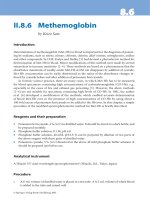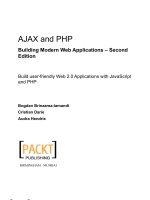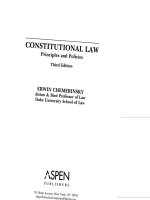Handbook of modern sensors : physics, designs, and applications - Third Edition docx
Bạn đang xem bản rút gọn của tài liệu. Xem và tải ngay bản đầy đủ của tài liệu tại đây (14.31 MB, 608 trang )
HANDBOOK OF
MODERN SENSORS
PHYSICS, DESIGNS, and APPLICATIONS
Third Edition
Springer
New York
Ber lin
Heidelberg
Hong Kong
London
Milan
Paris
Tokyo
HANDBOOK OF
MODERN SENSORS
PHYSICS, DESIGNS, and APPLICATIONS
Third Edition
JACOB FRADEN
Advanced Monitors Corporation
San Diego, California
With 403 Iillustrations
Jacob Fraden
Advanced Monitors Corporation
6255 Ferris Square, Suite M
San Diego, CA 92121
USA
Library of Congress Cataloging-in-Publication Data
Fraden, Jacob
Handbook of modern sensors : physics, designs, and applications / Jacob Fraden.–3rd ed.
p. cm.
Includes bibliographical references and index.
ISBN 0-387-00750-4 (alk. paper)
1. Detectors–Handbooks, manuals, etc. 2. Interface circuits–Handbooks, manuals, etc.
I. Title.
TA165.F723 2003
681
.2—dc21 2003044597
ISBN 0-387-00750-4 Printed on acid-free paper.
AIP Press is an imprint of Springer-Verlag, Inc.
© 2004, 1996 Springer-Verlag New York, Inc.
All rights reserved. This work may not be translated or copied in whole or in part without the written
permission of the publisher (Springer-Verlag New York, Inc., 175 Fifth Avenue, New York, NY 10010,
USA), except for brief excerpts in connection with reviews or scholarly analysis. Use in connection with
any form of information storage and retrieval, electronic adaptation, computer software, or by similar or
dissimilar methodology now known or hereafter developed is forbidden. The use in this publication of
trade names, trademarks, service marks, and similar terms, even if they are not identified as such, is not to
be taken as an expression of opinion as to whether or not they are subject to proprietary rights.
Printed in the United States of America.
987654321 SPIN 10919477
www.springer-ny.com
Springer-Verlag New York Berlin Heidelberg
A member of BertelsmannSpringer Science+Business Media GmbH
To the memory of my father
This page intentionally left blank
Preface
Seven years have passed since the publication of the previous edition of this book.
During that time, sensor technologies have made a remarkable leap forward. The
sensitivity of the sensors became higher, the dimensions became smaller, the selec-
tivity became better, and the prices became lower. What have not changed are the
fundamental principles of the sensor design. They are still governed by the laws of
Nature. Arguably one of the greatest geniuses who ever lived, Leonardo Da Vinci,
had his own peculiar way of praying. He was saying, “Oh Lord, thanks for Thou do
not violate your own laws.” It is comforting indeed that the laws of Nature do not
change as time goes by; it is just our appreciation of them that is being refined. Thus,
this new edition examines the same good old laws of Nature that are employed in
the designs of various sensors. This has not changed much since the previous edition.
Yet, the sections that describe the practical designs are revised substantially. Recent
ideas and developments have been added, and less important and nonessential designs
were dropped. Probably the most dramatic recent progress in the sensor technologies
relates to wide use of MEMS and MEOMS (micro-electro-mechanical systems and
micro-electro-opto-mechanical systems). These are examined in this new edition with
greater detail.
This book is about devices commonly called sensors. The invention of a mi-
croprocessor has brought highly sophisticated instruments into our everyday lives.
Numerous computerized appliances, of which microprocessors are integral parts,
wash clothes and prepare coffee, play music, guard homes, and control room tem-
perature. Microprocessors are digital devices that manipulate binary codes generally
represented by electric signals. Yet, we live in an analog world where these devices
function among objects that are mostly not digital. Moreover, this world is generally
not electrical (apart from the atomic level). Digital systems, however complex and
intelligent they might be, must receive information from the outside world. Sensors
are interface devices between various physical values and electronic circuits who
“understand” only a language of moving electrical charges. In other words, sensors
are the eyes, ears, and noses of silicon chips. Sensors have become part of everyone’s
life. In the United States alone, they comprise a $12 billion industry.
VIII Preface
In the course of my engineering work, I often felt a strong need for a book that
would combine practical information on diversified subjects related to the most impor-
tant physical principles, design, and use of various sensors. Surely, I could find almost
all I had to know in texts on physics, electronics, technical magazines, and manufac-
turers’ catalogs. However, the information is scattered over many publications, and
almost every question I was pondering required substantial research work and nu-
merous trips to the library. Little by little, I have been gathering practical information
on everything that in any way was related to various sensors and their applications
to scientific and engineering measurements. Soon, I realized that the information I
collected might be quite useful to more than one person. This idea prompted me to
write this book.
In setting my criteria for selecting various sensors for this edition, I attempted to
keep the scope of this book as broad as possible, opting for brief descriptions of many
different designs (without being trivial, I hope) rather than fewer treated in greater
depth. This volume attempts (immodestly perhaps) to cover a very broad range of
sensors and detectors. Many of them are well known, but describing them is still
useful for students and those who look for a convenient reference. It is the author’s
intention to present a comprehensive and up-to-date account of the theory (physical
principles), design, and practical implementations of various (especially the newest)
sensors for scientific, industrial, and consumer applications. The topics included in
the book reflect the author’s own preferences and interpretations. Some may find a
description of a particular sensor either too detailed or too broad or, contrary, too
brief. In most cases, the author tried to make an attempt to strike a balance between
a detailed description and a simplicity of coverage.
This volume covers many modern sensors and detectors. It is clear that one book
cannot embrace the whole variety of sensors and their applications, even if it is called
something like The Encyclopedia of Sensors. This is a different book, and the au-
thor’s task was much less ambitious. Here, an attempt has been made to generate a
reference text that could be used by students, researchers interested in modern instru-
mentation (applied physicists and engineers), sensor designers, application engineers,
and technicians whose job is to understand, select, and/or design sensors for practical
systems.
The previous editions of this book have been used quite extensively as desktop
references and textbooks for the related college courses. Comments and suggestions
from the sensordesigners, professors, and studentsprompted me to implementseveral
changes and correct errors.
Jacob Fraden
San Diego, California
November 2003
Contents
Preface VII
1 Data Acquisition 1
1.1 Sensors, Signals, and Systems 1
1.2 Sensor Classification 7
1.3 Units of Measurements 9
References 11
2 Sensor Characteristics 13
2.1 Transfer Function 13
2.2 Span (Full-Scale Input) 15
2.3 Full-Scale Output 16
2.4 Accuracy 17
2.5 Calibration 18
2.6 Calibration Error 19
2.7 Hysteresis 20
2.8 Nonlinearity 20
2.9 Saturation 22
2.10 Repeatability 23
2.11 Dead Band 23
2.12 Resolution 23
2.13 Special Properties 24
2.14 Output Impedance 24
2.15 Excitation 25
2.16 Dynamic Characteristics 25
2.17 Environmental Factors 29
2.18 Reliability 31
2.19 Application Characteristics 33
2.20 Uncertainty 33
References 35
X Contents
3 Physical Principles of Sensing 37
3.1 Electric Charges, Fields, and Potentials 38
3.2 Capacitance 44
3.2.1 Capacitor 45
3.2.2 Dielectric Constant 46
3.3 Magnetism 50
3.3.1 Faraday’s Law 52
3.3.2 Solenoid 54
3.3.3 Toroid 55
3.3.4 Permanent Magnets 55
3.4 Induction 56
3.5 Resistance 59
3.5.1 Specific Resistivity 60
3.5.2 Temperature Sensitivity 62
3.5.3 Strain Sensitivity 64
3.5.4 Moisture Sensitivity 65
3.6 Piezoelectric Effect 66
3.6.1 Piezoelectric Films 72
3.7 Pyroelectric Effect 76
3.8 Hall Effect 82
3.9 Seebeck and Peltier Effects 86
3.10 Sound Waves 92
3.11 Temperature and Thermal Properties of Materials 94
3.11.1 Temperature Scales 95
3.11.2 Thermal Expansion 96
3.11.3 Heat Capacity 98
3.12 Heat Transfer 99
3.12.1 Thermal Conduction 99
3.12.2 Thermal Convection 102
3.12.3 Thermal Radiation 103
3.12.3.1 Emissivity 106
3.12.3.2 Cavity Effect 109
3.13 Light 111
3.14 Dynamic Models of Sensor Elements 113
3.14.1 Mechanical Elements 115
3.14.2 Thermal Elements 117
3.14.3 Electrical Elements 118
3.14.4 Analogies 119
References 119
4 Optical Components of Sensors 123
4.1 Radiometry 125
4.2 Photometry 129
4.3 Windows 132
4.4 Mirrors 134
Contents XI
4.5 Lenses 136
4.6 Fresnel Lenses 137
4.7 Fiber Optics and Waveguides 140
4.8 Concentrators 144
4.9 Coatings for Thermal Absorption 145
4.10 Electro-optic and Acousto-optic Modulators 146
4.11 Interferometric Fiber-optic Modulation 148
References 149
5 Interface Electronic Circuits 151
5.1 Input Characteristics of Interface Circuits 151
5.2 Amplifiers 156
5.2.1 Operational Amplifiers 156
5.2.2 Voltage Follower 158
5.2.3 Instrumentation Amplifier 159
5.2.4 Charge Amplifiers 161
5.3 Excitation Circuits 164
5.3.1 Current Generators 165
5.3.2 Voltage References 169
5.3.3 Oscillators 171
5.3.4 Drivers 174
5.4 Analog-to-Digital Converters 175
5.4.1 Basic Concepts 175
5.4.2 V/F Converters 176
5.4.3 Dual-Slope Converter 181
5.4.4 Successive-Approximation Converter 183
5.4.5 Resolution Extension 185
5.5 Direct Digitization and Processing 186
5.6 Ratiometric Circuits 190
5.7 Bridge Circuits 192
5.7.1 Disbalanced Bridge 193
5.7.2 Null-Balanced Bridge 194
5.7.3 Temperature Compensation of Resistive Bridge 195
5.7.4 Bridge Amplifiers 200
5.8 Data Transmission 201
5.8.1 Two-Wire Transmission 202
5.8.2 Four-Wire Sensing 203
5.8.3 Six-Wire Sensing 204
5.9 Noise in Sensors and Circuits 204
5.9.1 Inherent Noise 205
5.9.2 Transmitted Noise 207
5.9.3 Electric Shielding 212
5.9.4 Bypass Capacitors 214
5.9.5 Magnetic Shielding 215
5.9.6 Mechanical Noise 217
XII Contents
5.9.7 Ground Planes 218
5.9.8 Ground Loops and Ground Isolation 219
5.9.9 Seebeck Noise 221
5.10 Batteries for Low Power Sensors 222
5.10.1 Primary Cells 223
5.10.2 Secondary Cells 224
References 225
6 Occupancy and Motion Detectors 227
6.1 Ultrasonic Sensors 228
6.2 Microwave Motion Detectors 228
6.3 Capacitive Occupancy Detectors 233
6.4 Triboelectric Detectors 237
6.5 Optoelectronic Motion Detectors 238
6.5.1 Sensor Structures 240
6.5.1.1 Multiple Sensors 241
6.5.1.2 Complex Sensor Shape 241
6.5.1.3 Image Distortion 241
6.5.1.4 Facet Focusing Element 242
6.5.2 Visible and Near-Infrared Light Motion Detectors 243
6.5.3 Far-Infrared Motion Detectors 244
6.5.3.1 PIR Motion Detectors 245
6.5.3.2 PIR Sensor Efficiency Analysis 247
References 251
7 Position, Displacement, and Level 253
7.1 Potentiometric Sensors 254
7.2 Gravitational Sensors 256
7.3 Capacitive Sensors 258
7.4 Inductive and Magnetic Sensors 262
7.4.1 LVDT and RVDT 262
7.4.2 Eddy Current Sensors 264
7.4.3 Transverse Inductive Sensor 266
7.4.4 Hall Effect Sensors 267
7.4.5 Magnetoresistive Sensors 271
7.4.6 Magnetostrictive Detector 274
7.5 Optical Sensors 275
7.5.1 Optical Bridge 275
7.5.2 Proximity Detector with Polarized Light 276
7.5.3 Fiber-Optic Sensors 278
7.5.4 Fabry–Perot Sensors 278
7.5.5 Grating Sensors 281
7.5.6 Linear Optical Sensors (PSD) 283
7.6 Ultrasonic Sensors 286
7.7 Radar Sensors 289
Contents XIII
7.7.1 Micropower Impulse Radar 289
7.7.2 Ground-Penetrating Radar 291
7.8 Thickness and Level Sensors 293
7.8.1 Ablation Sensors 293
7.8.2 Thin-Film Sensors 296
7.8.3 Liquid-Level Sensors 296
References 298
8 Velocity and Acceleration 301
8.1 Accelerometer Characteristics 303
8.2 Capacitive Accelerometers 305
8.3 Piezoresistive Accelerometers 307
8.4 Piezoelectric Accelerometers 309
8.5 Thermal Accelerometers 309
8.5.1 Heated-Plate Accelerometer 309
8.5.2 Heated-Gas Accelerometer 310
8.6 Gyroscopes 313
8.6.1 Rotor Gyroscope 313
8.6.2 Monolithic Silicon Gyroscopes 314
8.6.3 Optical Gyroscopes 317
8.7 Piezoelectric Cables 319
References 321
9 Force, Strain, and Tactile Sensors 323
9.1 Strain Gauges 325
9.2 Tactile Sensors 327
9.3 Piezoelectric Force Sensors 334
References 336
10 Pressure Sensors 339
10.1 Concepts of Pressure 339
10.2 Units of Pressure 340
10.3 Mercury Pressure Sensor 341
10.4 Bellows, Membranes, and Thin Plates 342
10.5 Piezoresistive Sensors 344
10.6 Capacitive Sensors 349
10.7 VRP Sensors 350
10.8 Optoelectronic Sensors 352
10.9 Vacuum Sensors 354
10.9.1 Pirani Gauge 354
10.9.2 Ionization Gauges 356
10.9.3 Gas Drag Gauge 356
References 357
XIV Contents
11 Flow Sensors 359
11.1 Basics of Flow Dynamics 359
11.2 Pressure Gradient Technique 361
11.3 Thermal Transport Sensors 363
11.4 Ultrasonic Sensors 367
11.5 Electromagnetic Sensors 370
11.6 Microflow Sensors 372
11.7 Breeze Sensor 374
11.8 Coriolis Mass Flow Sensors 376
11.9 Drag Force Flow Sensors 377
References 378
12 Acoustic Sensors 381
12.1 Resistive Microphones 382
12.2 Condenser Microphones 382
12.3 Fiber-Optic Microphone 383
12.4 Piezoelectric Microphones 385
12.5 Electret Microphones 386
12.6 Solid-State Acoustic Detectors 388
References 391
13 Humidity and Moisture Sensors 393
13.1 Concept of Humidity 393
13.2 Capacitive Sensors 396
13.3 Electrical Conductivity Sensors 399
13.4 Thermal Conductivity Sensor 401
13.5 Optical Hygrometer 402
13.6 Oscillating Hygrometer 403
References 404
14 Light Detectors 407
14.1 Introduction 407
14.2 Photodiodes 411
14.3 Phototransistor 418
14.4 Photoresistors 420
14.5 Cooled Detectors 423
14.6 Thermal Detectors 425
14.6.1 Golay Cells 426
14.6.2 Thermopile Sensors 427
14.6.3 Pyroelectric Sensors 430
14.6.4 Bolometers 434
14.6.5 Active Far-Infrared Sensors 437
14.7 Gas Flame Detectors 439
References 441
Contents XV
15 Radiation Detectors 443
15.1 Scintillating Detectors 444
15.2 Ionization Detectors 447
15.2.1 Ionization Chambers 447
15.2.2 Proportional Chambers 449
15.2.3 Geiger–Müller Counters 450
15.2.4 Semiconductor Detectors 451
References 455
16 Temperature Sensors 457
16.1 Thermoresistive Sensors 461
16.1.1 Resistance Temperature Detectors 461
16.1.2 Silicon Resistive Sensors 464
16.1.3 Thermistors 465
16.1.3.1 NTC Thermistors 465
16.1.3.2 Self-Heating Effect in NTC Thermistors 474
16.1.3.3 PTC Thermistors 477
16.2 Thermoelectric Contact Sensors 481
16.2.1 Thermoelectric Law 482
16.2.2 Thermocouple Circuits 484
16.2.3 Thermocouple Assemblies 486
16.3 Semiconductor P-N Junction Sensors 488
16.4 Optical Temperature Sensors 491
16.4.1 Fluoroptic Sensors 492
16.4.2 Interferometric Sensors 494
16.4.3 Thermochromic Solution Sensor 494
16.5 Acoustic Temperature Sensor 495
16.6 Piezoelectric Temperature Sensors 496
References 497
17 Chemical Sensors 499
17.1 Chemical Sensor Characteristics 500
17.2 Specific Difficulties 500
17.3 Classification of Chemical-Sensing Mechanisms 501
17.4 Direct Sensors 503
17.4.1 Metal-Oxide Chemical Sensors 503
17.4.2 ChemFET 504
17.4.3 Electrochemical Sensors 505
17.4.4 Potentiometric Sensors 506
17.4.5 Conductometric Sensors 507
17.4.6 Amperometric Sensors 508
17.4.7 Enhanced Catalytic Gas Sensors 510
17.4.8 Elastomer Chemiresistors 512
17.5 Complex Sensors 512
17.5.1 Thermal Sensors 513
XVI Contents
17.5.2 Pellister Catalytic Sensors 514
17.5.3 Optical Chemical Sensors 514
17.5.4 Mass Detector 516
17.5.5 Biochemical Sensors 519
17.5.6 Enzyme Sensors 520
17.6 Chemical Sensors Versus Instruments 520
17.6.1 Chemometrics 523
17.6.2 Multisensor Arrays 524
17.6.3 Electronic Noses (Olfactory Sensors) 524
17.6.4 Neural Network Signal (Signature) Processing for
Electronic Noses 527
17.6.5 “Smart” Chemical Sensors 530
References 530
18 Sensor Materials and Technologies 533
18.1 Materials 533
18.1.1 Silicon as a Sensing Material 533
18.1.2 Plastics 536
18.1.3 Metals 540
18.1.4 Ceramics 542
18.1.5 Glasses 543
18.2 Surface Processing 543
18.2.1 Deposition of Thin and Thick Films 543
18.2.2 Spin-Casting 544
18.2.3 Vacuum Deposition 544
18.2.4 Sputtering 545
18.2.5 Chemical Vapor Deposition 546
18.3 Nano-Technology 547
18.3.1 Photolithography 548
18.3.2 Silicon Micromachining 549
18.3.2.1 Basic Techniques 549
18.3.2.2 Wafer bonding 554
References 555
Appendix 557
Table A.1 Chemical Symbols for the Elements 557
Table A.2 SI Multiples 558
Table A.3 Derivative SI Units 558
Table A.4 SI Conversion Multiples 559
Table A.5 Dielectric Constants of Some Materials
at Room Temperature 564
Table A.6 Properties of Magnetic Materials 564
Table A.7 Resistivities and Temperature Coefficients
of Resistivity of Some Materials at Room Temperature 565
Table A.8 Properties of Piezoelectric Materials at 20
◦
C 565
Contents XVII
Table A.9 Physical Properties of Pyroelectric Materials 566
Table A.10 Characteristics of Thermocouple Types 566
Table A.11 Thermoelectric Coefficients and Volume Resistivities
of Selected Elements 567
Table A.11a Thermocouples for Very Low and Very
High Temperatures 567
Table A.12 Densities of Some Materials 568
Table A.13 Mechanical Properties of Some Solid Materials 568
Table A.14 Mechanical Properties of Some Crystalline Materials 569
Table A.15 Speed of Sound Waves 569
Table A.16 Coefficient of Linear Thermal Expansion
of Some Materials 569
Table A.17 Specific Heat and Thermal Conductivity
of Some Materials 570
Table A.18 Typical Emissivities of Different Materials 571
Table A.19 Refractive Indices of Some Materials 572
Table A.20 Characteristics of C–Zn and Alkaline Cells 573
Table A.21 Lithium–Manganese Dioxide Primary Cells 573
Table A.22 Typical Characteristics of “AA”-Size Secondary Cells 573
Table A.23 Miniature Secondary Cells and Batteries 574
Table A.24 Electronic Ceramics 576
Table A.25 Properties of Glasses 577
Index 579
This page intentionally left blank
1
Data Acquisition
“It’s as large as life, and twice as natural”
—Lewis Carroll, “Through the Looking Glass”
1.1 Sensors, Signals, and Systems
Asensor is often defined as a device that receives and responds to a signal or stimulus.
This definition is broad. In fact, it is so broad that it covers almost everything from
a human eye to a trigger in a pistol. Consider the level-control system shown in Fig.
1.1 [1]. The operator adjusts the level of fluid in the tank by manipulating its valve.
Variations in the inlet flow rate, temperature changes (these would alter the fluid’s
viscosity and, consequently, the flow rate through the valve), and similar disturbances
must be compensatedfor by the operator. Without control, the tank is likely to flood, or
run dry. To act appropriately, the operator must obtain information about the level of
fluid in the tank on a timely basis. In this example, the information is perceived by the
sensor, which consists of two main parts: the sight tube on the tank and the operator’s
eye, which generates an electric response in the optic nerve. The sight tube by itself is
not a sensor, and in this particular control system, the eye is not a sensor either. Only
the combination of these two components makes a narrow-purpose sensor (detector),
which is selectively sensitive to the fluid level. If a sight tube is designed properly,
it will very quickly reflect variations in the level, and it is said that the sensor has a
fast speed response. If the internal diameter of the tube is too small for a given fluid
viscosity, the level in the tube may lag behind the level in the tank. Then, we have to
consider a phase characteristic of such a sensor. In some cases, the lag may be quite
acceptable, whereasinother cases, a bettersighttubedesign would berequired.Hence,
the sensor’s performance must be assessed only as a part of a data acquisition system.
This world is divided into natural and man-made objects. The natural sensors,
like those found in living organisms, usually respond with signals, having an electro-
chemical character; that is, their physical nature is based on ion transport, like in the
nerve fibers (such as an optic nerve in the fluid tank operator). In man-made devices,
2 1 Data Acquisition
Fig. 1.1. Level-control system. A sight tube and operator’s eye form a sensor (a device which
converts information into electrical signal).
information is also transmitted and processed in electrical form—however, through
the transport of electrons. Sensors that are used in artificial systems must speak the
same language as the devices with which they are interfaced. This language is electri-
cal in its nature and a man-made sensor should be capable of responding with signals
where information is carried by displacement of electrons, rather than ions.
1
Thus,
it should be possible to connect a sensor to an electronic system through electrical
wires, rather than through an electrochemical solution or a nerve fiber. Hence, in this
book, we use a somewhat narrower definition of sensors, which may be phrased as
A sensor is a device that receives a stimulus and responds with an
electrical signal.
The term stimulus is used throughout this book andneeds to be clearly understood.
The stimulus is the quantity, property, or condition that is sensed and converted into
electrical signal. Some texts (for instance, Ref. [2]) use a different term, measurand,
which has the same meaning, however with the stress on quantitative characteristic
of sensing.
The purpose of a sensor is to respond to some kind of an input physical property
(stimulus) and to convert it intoanelectricalsignalwhichiscompatiblewithelectronic
circuits. We may say that a sensor is a translator of a generally nonelectrical value
into an electrical value. When we say “electrical,” we mean a signal which can be
channeled, amplified, and modified by electronic devices. The sensor’s output signal
may be in the form of voltage, current, or charge. These may be further described
in terms of amplitude, frequency, phase, or digital code. This set of characteristics is
called the output signal format. Therefore, a sensor has input properties (of any kind)
and electrical output properties.
1
There is a very exciting field of the optical computing and communications where informa-
tion is processed by a transport of photons. That field is beyond the scope of this book.
1.1 Sensors, Signals, and Systems 3
Fig. 1.2. A sensor may incorporate several transducers. e
1
,e
2
, and so on are various types of
energy. Note that the last part is a direct sensor.
Any sensor is an energy converter. No matter what you try to measure, you al-
ways deal with energy transfer from the object of measurement to the sensor. The
process of sensing is a particular case of information transfer, and any transmission of
information requires transmission of energy. Of course, one should not be confused
by an obvious fact that transmission of energy can flow both ways—it may be with
a positive sign as well as with a negative sign; that is, energy can flow either from
an object to the sensor or from the sensor to the object. A special case is when the
energy is zero, and it also carries information about existence of that particular case.
For example, a thermopile infrared radiation sensor will produce a positive voltage
when the object is warmer than the sensor (infrared flux is flowing to the sensor) or
the voltage is negative when the object is cooler than the sensor (infrared flux flows
from the sensor to the object). When both the sensor and the object are at the same
temperature, the flux is zero and the output voltage is zero. This carries a message
that the temperatures are the same.
The term sensor should be distinguished from transducer. The latter is a converter
of one type ofenergy into another, whereas the former converts anytype of energy into
electrical. An example of a transducer is a loudspeaker which converts an electrical
signal into a variable magnetic field and, subsequently, into acoustic waves.
2
This is
nothing to do with perception or sensing. Transducers may be used as actuators in
various systems. An actuator may be described as opposite to a sensor—it converts
electrical signal into generally nonelectrical energy. For example, an electric motor
is an actuator—it converts electric energy into mechanical action.
Transducers may be parts of complex sensors (Fig. 1.2). For example, a chemical
sensor may have a part which converts the energy of a chemical reaction into heat
(transducer) and another part, a thermopile, which converts heat into an electrical sig-
nal. The combination of the two makes a chemical sensor—a device which produces
an electrical signal in response to a chemical reaction. Note that in the above example,
a chemical sensor is a complex sensor; it is comprised of a transducer and another
sensor (heat). This suggests that many sensors incorporate at least one direct-type
sensor and a number of transducers. The direct sensors are those that employ such
physical effects that make a direct energy conversion into electrical signal genera-
tion or modification. Examples of such physical effects are photoeffect and Seebeck
effect. These will be described in Chapter 3.
2
It is interesting to note that a loudspeaker, when connected to an input of an amplifier, may
function as a microphone. In that case, it becomes an acoustical sensor.
4 1 Data Acquisition
In summary, there are two types of sensors: direct and complex. A direct sensor
converts a stimulus into an electrical signal or modifies an electrical signal by using
an appropriate physical effect, whereas a complex sensor in addition needs one or
more transducers of energy before a direct sensor can be employed to generate an
electrical output.
A sensor does not function by itself; it is always a part of a larger system that
may incorporate many other detectors, signalconditioners,signalprocessors, memory
devices, data recorders, and actuators. The sensor’s place in a device is either intrinsic
or extrinsic. It may be positioned at the input of a device to perceive the outside effects
and to signal the system about variations in the outside stimuli. Also, it may be an
internal part of a device that monitors the devices’ own state to cause the appropriate
performance. A sensor is always a part of some kind of a data acquisition system.
Often, such a system may be a part of a larger control system that includes various
feedback mechanisms.
Toillustrate the place of sensors in a larger system, Fig. 1.3 shows a block diagram
of a data acquisition and control device. An object can be anything: a car, space ship,
animal or human, liquid, or gas. Any material object may become a subject of some
kind of a measurement. Data are collected from an object by a number of sensors.
Some of them (2, 3, and 4) are positioned directly on or inside the object. Sensor 1
perceives the object without a physical contact and, therefore, is called a noncontact
sensor. Examples of such a sensor is a radiation detector and a TV camera. Even if
Fig. 1.3. Positions of sensors in a data acquisition system. Sensor 1 is noncontact, sensors 2
and 3 are passive, sensor 4 is active, and sensor 5 is internal to a data acquisition system.
1.1 Sensors, Signals, and Systems 5
we say “noncontact”, we remember that energy transfer always occurs between any
sensor and an object.
Sensor 5 serves a different purpose. It monitors internal conditions of a data
acquisition system itself. Some sensors (1 and 3) cannot be directly connected to
standard electronic circuits because of inappropriate output signal formats. They re-
quire the use of interface devices (signal conditioners). Sensors 1, 2, 3, and 5 are
passive. They generate electric signals without energy consumption from the elec-
tronic circuits. Sensor 4 is active. It requires an operating signal, which is provided
by an excitation circuit. This signal is modified by the sensor in accordance with the
converted information. An example of an active sensor is a thermistor, which is a
temperature-sensitive resistor. It may operate with a constant-current source, which
is an excitation circuit. Depending on the complexity of the system, the total number
of sensors may vary from as little as one (a home thermostat) to many thousands (a
space shuttle).
Electrical signals from the sensors are fed into a multiplexer (MUX), which is a
switch or a gate. Its function is to connect sensors one at a time to an analog-to-digital
(A/D) converter if a sensor produces an analog signal, or directly to a computer if
a sensor produces signals in a digital format. The computer controls a multiplexer
and an A/D converter for the appropriate timing. Also, it may send control signals to
the actuator, which acts on the object. Examples of actuators are an electric motor, a
solenoid, a relay, and a pneumatic valve.The system contains some peripheral devices
(for instance, a data recorder, a display, an alarm, etc.) and a number of components,
which are not shown in the block diagram. These may be filters, sample-and-hold
circuits, amplifiers, and so forth.
Toillustrate how such a system works, letusconsiderasimplecar-door monitoring
arrangement. Every door in a car is supplied with a sensor which detects the door
position (open or closed). In most cars, the sensor is a simple electric switch. Signals
from all door sensors go to the car’s internal microprocessor (no need for an A/D
converter as all door signals are in a digital format: ones or zeros). The microprocessor
identifies which door is openandsends an indicating signal to the peripheral devices(a
dashboard display and an audible alarm). A car driver (the actuator) gets the message
and acts on the object (closes the door).
An example of a more complex device is an anesthetic vapor delivery system.
It is intended for controlling the level of anesthetic drugs delivered to a patient by
means of inhalation during surgical procedures. The system employs several active
and passive sensors. The vapor concentration of anesthetic agents (such as halothane,
isoflurane, or enflurane) is selectively monitored by an active piezoelectric sensor,
installed into a ventilation tube. Molecules of anesthetic vapors add mass to the
oscillating crystal in the sensor and change its natural frequency, which is a measure
of vapor concentration. Several other sensors monitor the concentration of CO
2
,to
distinguish exhale from inhale, and temperature and pressure, to compensate for
additional variables. All of these data are multiplexed, digitized, and fed into the
microprocessor, which calculates the actual vapor concentration. An anesthesiologist
presets a desired delivery level and the processor adjusts the actuator (the valves) to
maintain anesthetics at the correct concentration.
6 1 Data Acquisition
Fig. 1.4. Multiple sensors, actuators, and warning signals are parts of the Advanced Safety
Vehicle. (Courtesy of Nissan Motor Company.)
Another example of a complex combination of various sensors, actuators, and
indicating signals is shown in Fig. 1.4. It is an Advanced Safety Vehicle (ASV) that is
being developed by Nissan. The system is aimed at increasing safety of a car.Among
many others, it includes a drowsiness warning system and drowsiness relieving sys-
tem. This may include the eyeball movement sensor and the driver head inclination
detector. The microwave, ultrasonic, and infrared range measuring sensors are incor-
porated into the emergency braking advanced advisory system to illuminate the break
lamps even before the driver brakes hard in an emergency, thus advising the driver
of a following vehicle to take evasive action. The obstacle warning system includes
both the radar and infrared (IR) detectors. The adaptive cruise control system works
if the driver approaches too closely to a preceding vehicle: The speed is automatically
reduced to maintain a suitable safety distance. The pedestrian monitoring system de-
tects and alerts the driver to the presence of pedestrians at night as well as in vehicle
blind spots. The lane control system helps in the event that the system detects and de-
termines that incipient lane deviation is not the driver’s intention. It issues a warning
and automatically steers the vehicle, if necessary, to prevent it from leaving its lane.
In the following chapters, we concentrate on methods of sensing, physical princi-
ples of sensors operations, practical designs, and interface electronic circuits. Other
essential parts of the control and monitoring systems, such as actuators, displays,
data recorders, data transmitters, and others, are beyond the scope of this book and
mentioned only briefly.
Generally, the sensor’s input signals (stimuli) may have almost any conceivable
physical or chemical nature (e.g., light flux, temperature, pressure, vibration, dis-
placement, position, velocity, ion concentration, ). The sensor’s design may be
of a general purpose. A special packaging and housing should be built to adapt it
for a particular application. For instance, a micromachined piezoresistive pressure
sensor may be housed into a watertight enclosure for the invasive measurement of
aortic blood pressure through a catheter. The same sensor will be given an entirely
different enclosure when it is intended for measuring blood pressure by a noninvasive









